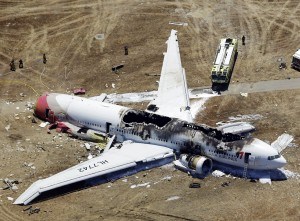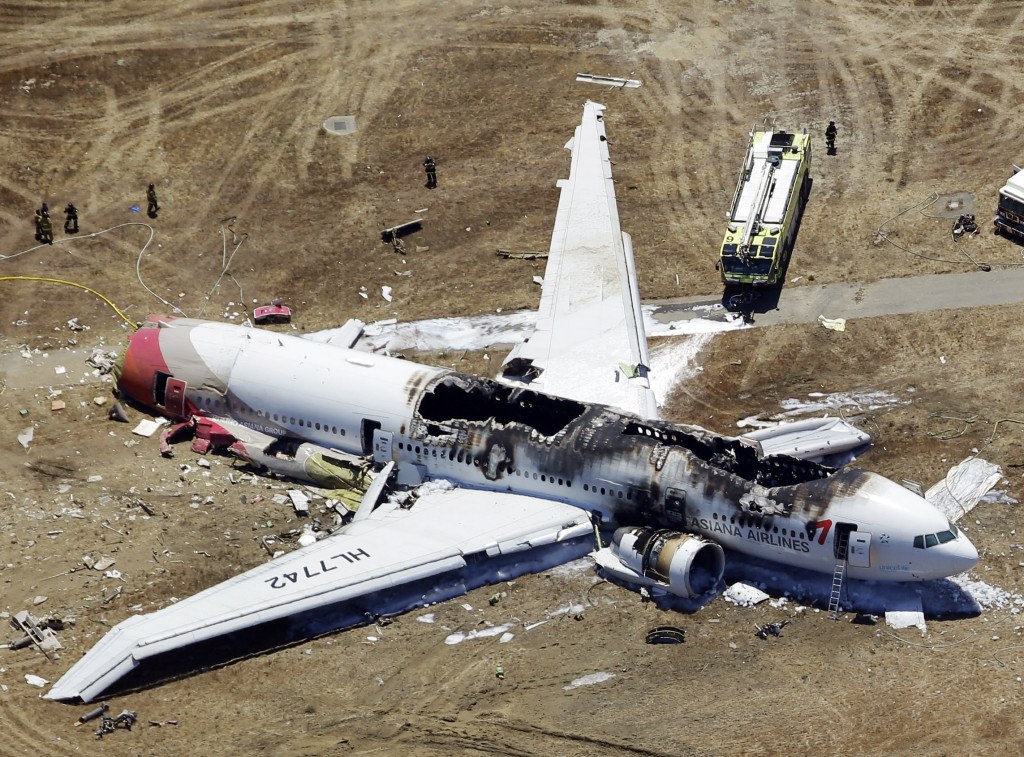While the National Transportation Safety Board (NTSB) continues its investigation, lawsuits are already being filed in the July 6 Asiana Airlines plane crash in San Francisco that resulted in 181 injured passengers and two dead teens.

(AP Photo/Marcio Jose Sanchez)
The NTSB completed its examination of the airplane wreckage and runway, but the ongoing investigation will include additional interviews, examination of the evacuation slides and other airplane components as well as an in-depth analysis of the airplane’s performance.
David McMahon, a partner with Barger & Wolen, represents insurers involved in litigation resulting from natural disasters as well as in product liability lawsuits against the airline and cruise industry.
In an interview with Claims Journal, he explained how the Montreal Convention may limit the number of lawsuits filed against Asiana Airlines.
The Montreal Convention of 1999 established uniformity in governing international airline liability and provided some limitations to benefit air carriers, he said.
“One of the things that the Montreal Convention prevents people from doing is from filing a lawsuit in the United States if their final destination was outside of the country,” said McMahon.
For example, there were a number of passengers from South Korea on board the Asiana flight. If they held a round trip ticket to and from South Korea, they would be unable to sue Asiana.
“Under the Montreal Convention, I think what it’s designed to do is to give jurisdiction to the countries where someone is departing on a flight and ends up there. It makes sure that the place where the ticket was purchased and negotiated; the rules of that country apply to compensating the victims. In many countries, that kind of deprives the plaintiffs of a remedy, because very few countries have a tort system that is as advantageous as the tort system in the United States,” said McMahon.
Product Liability Suits
While the Montreal Convention protects the airlines against lawsuits filed as a result of crashes, it doesn’t protect other companies, like the airplane or plane parts manufacturers against product liability claims or lawsuits. Complaints filed based on that theory would circumvent the compensatory damage caps imposed by the Montreal Convention, McMahon said.
A lawsuit based on the product liability theory has already been filed against Boeing, the airplane manufacturer. The Ribbeck law firm recently filed a petition on behalf of 83 passengers in Cook County, Ill.
“We have started the discovery process against Boeing because of the information provided by the NTSB and our clients. For example, the sliding ramps deployed inside of the cabin further injuring our clients, the seatbelt of many of the passengers had to be cut off with a knife by the firemen causing our clients furthers psychological trauma of being trap[ped] in a plane that was about to explode. In addition, my clients inhaled fumes while being trap[ped] in their seats,” Ribbeck attorney Monica Kelly said in a statement to Claims Journal.
Kelly said that many of the oxygen masks did not deploy and indicated there were additional component parts failures in the Boeing 777.
“If they were going against Boeing, they might be able to sidestep that because the Montreal Convention deals with compensating victims of air disasters and lawsuits against the air carriers. It does not apply to product liability claims, like against Boeing,” the San Francisco-based attorney said.
Kelly, a seasoned aviation attorney said that the airline, as well as other defendants, would be added shortly.
“Asiana Airlines, the training company of the crew, San Francisco airport, etc… will be added to the complaint once we file the complaint against Boeing. We will be filing the complaint this week,” Kelly said in her statement.
Airline Sued
A suit against the airline has been filed in California by Younga Jun Machorro and her son, who were passengers on the plane. The suit alleges the Asiana flight crew were grossly negligence and reckless in their handling of the flight. The Machorros allege bodily injury and emotional distress as a result of the crash. Their attorney, Michael Verna, did not respond to a request for a statement.
The suit filed by the Machorros has taken a different approach, according to McMahon.
“They sued Asiana in the United States district court for the Northern District of California. I think that there is likely jurisdiction here, and this would be at least one of the proper venues. They squarely bring their lawsuit under the Montreal Convention. Now, one of the other facets of the Montreal Convention is that it provides a damage limitation cap. That cap is about $150,000 for physical damages, unless the airline can show that the incident was not due to their negligence,” said McMahon. “Then they have a second cause of action for gross negligence. I think that would be designed to blow the potential cap on liability. Then they have a third cause of action for loss of consortium.”
According to the seasoned maritime and aviation defense attorney, there is always a race to the courthouse in these types of cases. The Chicago and California lawsuits demonstrate two completely separate approaches, he said.
“It’s interesting, why Bowles and Verna would not name Boeing in the case. Perhaps they’re doing it for simplicity, but obviously, it shows that there are at least two main strategies that the plaintiff’s lawyers may employ here,” McMahon said.
A simple reason to name only one party in a suit may be to avoid expensive discovery. The plaintiffs may be relying on the likelihood that the target defendant, Asiana, will bring in all interested parties.
“You think that in the Northern District of California case, clearly Asiana is going to what we would call “third party in” Boeing and any of the other component‑part manufacturers who they may believe played a role in this. What’s so interesting, from at least the initial reports, it seems, from what we know now, that the predominant cause of this is pilot error. They were flying way too slowly, and they were off‑line. Now, I saw a news report about the Chicago lawsuit, and I guess they’re focusing on the auto‑throttle here. I guess when they were coming in, the pilots at least say that they took measures to increase speed and the auto‑throttle did not respond. You’ve got to believe that the investigation by the National Transportation Safety Board, that’s going to be something that they really focus on, whether or not that played a role, or they were going so slow and deployed it so late that the components just didn’t have time to speed up,” said McMahon.
San Francisco appears to be an appropriate jurisdiction to file suit, he said.
“One would think that the plaintiffs have a decent, pretty good argument, I would think, that if they were on a flight and got injured because of a defective product in San Francisco, Calif., that they should be able to sue for financial compensation in an appropriate jurisdiction in the United States. It’s a little surprising, I think, why the plaintiff’s attorneys chose Chicago. I mean, plaintiff’s attorneys typically like San Francisco, because it is a very liberal jurisdiction. I would see no impediments to bringing a lawsuit against Boeing here. Clearly there would be jurisdiction,” said McMahon.
Subrogation
The final NTSB report will play a big role in determining subrogation reinsurance claims, he said.
According to McMahon, Asiana had about $2.2 billion in insurance coverage for liability, another $3 million for the crew, and $ 130 million in hull coverage – coverage that insures the airplane itself.
Because the plane hit the seawall before crashing, the city and county of San Francisco will likely submit a claim to their first party property insurer who, according to McMahon, will adjust the loss and pay the city and county a fair value of either the replacement cost or the cost minus depreciation.
“That carrier, then, would pursue Asiana or Boeing, or both, for those claims,” McMahon said. “That’s a good example of an easy subrogation claim. Any of these carriers that end up paying will likely pursue additional claims against the party that’s predominantly culpable. A lot will be determined from the National Transportation Safety Board investigation and from discovery in the case.”
Slow Resolution to Lawsuits
Regardless of the number of lawsuits that arise from the Asiana crash, resolution will take time. McMahon estimated the cases will take almost two years to get resolved.
“Typically, in situations like this, most of the victims who are seriously hurt, there’s going to be settlements of those. The initial facts are suggesting that this didn’t happen without negligence. I mean, the pilots themselves and everything that’s pointing to them indicates negligence, if not gross negligence. One would think that the defense lawyers that get involved in this would start focusing on the amount of damages relatively quickly, just like in any big disaster like this. Three people were killed, so those would be the highest‑value claims. There are a lot of lower‑extremity and spinal‑injury claims because the plane spun on its wings and really slammed into the runway. Then, people that were more in the forward section of the plane, who weren’t that seriously injured. One would think that they would try to get the easier claims out of the way and then focus on the damages,” said McMahon.
The chairwoman of the NTSB has said the agency typically takes 12 to 18 months to complete its report. In this case, they’re hoping finish it under the 12‑month mark, McMahon said.
“Obviously, the plaintiff’s lawyers will be very interested in getting that report,” McMahon said.
The secured wreckage remains available for further examination at the San the Francisco International Airport.
Was this article valuable?
Here are more articles you may enjoy.


 Uber Spends Six Figures on Ads in Latest NY Insurance Reform Push
Uber Spends Six Figures on Ads in Latest NY Insurance Reform Push  Auto Lobbying Groups Unite to Pressure Trump for Tariff Relief
Auto Lobbying Groups Unite to Pressure Trump for Tariff Relief  Survey Shows Distracted Drivers Overconfident: 20% Text While Driving, 15% Use Social Media
Survey Shows Distracted Drivers Overconfident: 20% Text While Driving, 15% Use Social Media  Lawsuits Against BP Over Health Impacts of Deepwater Horizon Cleanup Stalled in Court
Lawsuits Against BP Over Health Impacts of Deepwater Horizon Cleanup Stalled in Court 